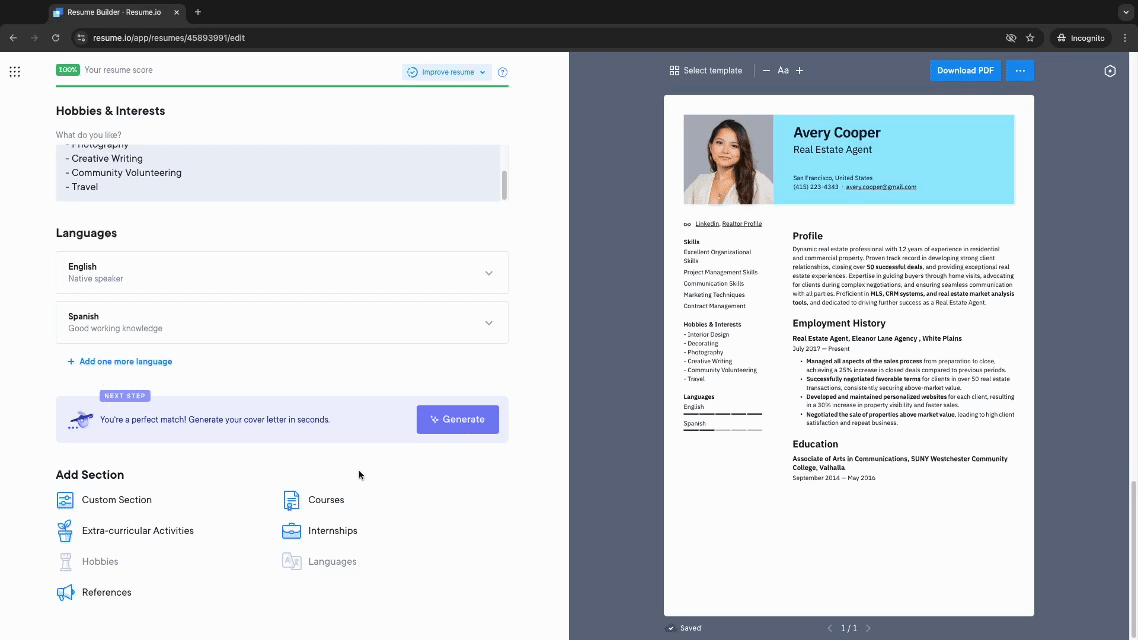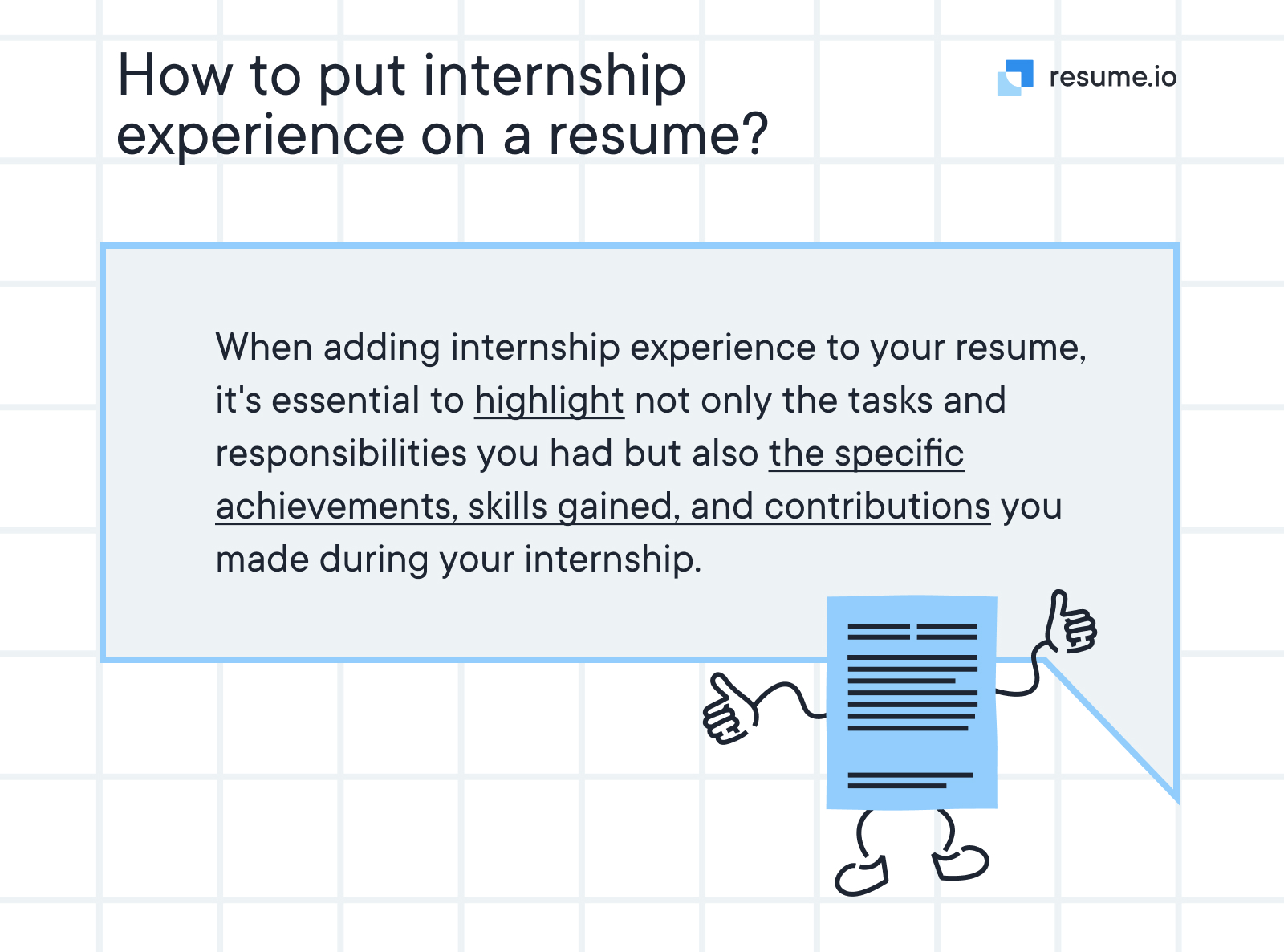Completing an internship is an excellent way to gain professional experience and build your resume. It can be confusing, however, to know the best way to put internship experience on your resume.
This article will walk you step-by-step through how to add an internship to your resume, including
- When to include internship experience on your resume (and when not to)
- Where to to put it
- What information to include
- Examples of internship experience on a resume
When to add internship experience to your resume
Because a resume’s goal is to market your background for a position, you should add relevant internship experience if it makes you a more compelling candidate.
If your internship is in progress or has been completed recently, and is related to the type of role you’re seeking, include it on your resume. This applies whether you’re new to the workforce or making a career change and have internship experience in your new industry.
There’s no need to specify on your resume whether an internship was paid or unpaid. Even if you completed an unpaid internship, you’ve still done the work and made the achievements, so it belongs on your resume.
When should you avoid including an internship?
There are a few situations when you may choose not to add an internship to your resume. One such scenario is if your internship has not yet begun. A resume should reflect actual accomplishments, so there’s no benefit to including something that hasn’t yet.
Another time to leave off your internship experience is if it’s less relevant to the work you’re seeking than other experience. For instance, if you are applying to software development jobs and you have multiple side projects or have created an app, those accomplishments are more compelling to include than your internship in human resources.
As you progress in your career and gain more full-time experience, you can start thinking about removing your internships from your resume in favor of your professional experience.
Where to display internship experience on a resume
Now that you know when to add this info, it’s important to understand where and how to list an internship on your resume. There are a few options.
First, if your work history is light, you can add your internship to your resume’s work experience section. This makes the most sense if you have little other experience to display.
Alternatively, you could include internship experience in an internship-specific section. This is optimal for those who have substantial full-time work experience but still want their resume to reflect internship experience.


Example of an internship resume section
WORK EXPERIENCE
Walmart, Chicago, IL | Cashier
January 2022 - May 2023
- Processed customer transactions in a fast-paced superstore environment.
- Earned 100% customer satisfaction rating.
INTERNSHIP EXPERIENCE
Digital Solutions, Inc, Chicago, IL | Marketing Intern
May 2023 - August 2023
- Developed and implemented social media strategies, resulting in 10% increase in online engagement.
- Conducted market research to identify trends and provide insights.
- Assisted in digital content creation, leading to 20% increase in traffic.
Example of an internship in the work experience section
WORK EXPERIENCE
Digital Solutions, Inc, Chicago, IL | Marketing Intern
May 2023 - August 2023
- Developed and implemented social media strategies, resulting in 10% increase in online engagement.
- Conducted market research to identify trends and provide insights.
- Assisted in digital content creation, leading to 20% increase in traffic.
Walmart, Chicago, IL | Cashier
January 2022 - May 2023
- Processed customer transactions in a fast-paced superstore environment.
- Earned 100% customer satisfaction rating.
Internship information to include on a resume
Regardless of where your internship experience is located, the most important aspect is how you write work experience on a resume. This information should describe your accomplishments, impacts, and achievements during your internship.
Start with a heading that includes your title, company, and dates of service. If you’re adding this role to a general experience section instead of an internship section, you’ll want to be sure it’s clear this role was an internship.
Then, under each heading, include details in concise bullet points. It’s tempting to draft a list of your daily job duties, but go beyond that by thinking about specific metrics or deliverables you achieved. You can list some responsibilities, as well, but the bulk of the information should show what you actually contributed or achieved.
Choose a resume format that is simple, streamlined, and easy to read.
Add graphics, images, or multiple colors.
What if you have no internship experience?
If you’re seeking an internship but don’t yet have any internships on your resume, be sure to list your education on your resume in detail, as education can sometimes make up for a lack of experience.
At the same time, consider including relevant projects, part-time employment, or freelance work to show your ability to do the job.
Then, once you land an internship, you’ll have all the tools to display it proudly on your resume.
Key takeaways
- Include internships on your resume when they’re recent and relevant. Remove them if they’re more than several years old, are irrelevant to your ideal job, or haven’t started yet.
- Put internship experience in its own section on your resume or in the general work experience section.
- Include the company, title, dates of employment, and major accomplishments and responsibilities.





